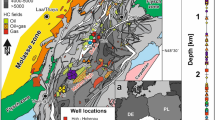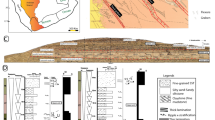Abstract
A petrophysical facies is a mappable rock unit of similar petrophysical characteristics, imparted by the depositional and diagenetic environment. Capillary-pressure curves are the basis for delineating a petrophysical facies.
Important parameters that affect the shape of a capillary-pressure curve are sorting of the pore-throat size distribution, the maximum threshold-entry radius, and percent recovery efficiency. Curve types based on these parameters are spatially clustered both laterally and vertically within the Red River Formation. The ordering of petrophysical facies, vertically up-hole, is related to the maximum threshold-entry radius which range from very small radii ‘A’ to very large radii ‘F’, with ‘C’ and ‘D’ of moderate size as defined in the construction of curve type designation. In the Red River depositional sequences, petrophysical facies are ordered by ‘B-C-D-C-B’, where either ‘A’, ‘E’, ‘F’, or PS is found at the bottom or top of the sequence, defining a sandwiched sequence of pore throats with the optimum reservoir facies in the center.
The maximum-threshold entry radius, apparent porosity, and recovery efficiency are logged for each lithologic unit. Large maximum threshold-entry radii are associated with poorly sorted pore-throat size distributions and/or little to no porosity. Recovery efficiency is only meaningful for dolostones with moderate to high porosity.
Similar content being viewed by others
References
CLEMENT, J.H., 1978, Depositional sequences and characteristics of Ordovician Red River producing zones, Pennel Field, Cedar Creek Anticline, Fallon County, Montana (Abstract)in Montana Geological Society Guidebook: Williston Basin Symposium, p. 97.
DULLIEN, F.A.L. and DHAWAN, G.K., 1974, Characterization of pore structure by a combination of quantitative photomicrography and mercury porosimetry:Journal of Colloid and Interface Science, v. 47, p. 337–349.
DULLIEN, F.A.L. and DHAWAN, G.K., 1975, New network permeability model of porous media:American Institute of Chemical Engineering Journal, v. 21, p. 299–307.
FRIEDMAN, G.M., RUZYLA, K., and REECKMANN, A., 1981, Effects of porosity type, pore geometry and diagenetic history on Tertiary recovery of petroleum from carbonate reservoirs: U. S. Department of Commerce, National Technical Information Service, 217 p.
RUZYLA, K., 1980, The relationship of diagenesis to porosity development and pore geometry in the Red River Formation (Upper Ordovician), Cabin Creek Field, Montana: Unpublished Doctoral Thesis, Rensselaer Polytechnic Institute, Troy, New York, 200 p.
RUZYLA, K. and FRIEDMAN, G.M., 1982, Geological heterogeneities important to future enhanced recovery in Carbonate reservoirs of Upper Ordovician Red River Formation at Cabin Creek Field, Montana:Society of Petroleum Engineers Journal, v. 22, p. 429–444.
RUZYLA, K. and FRIEDMAN, G.M., 1985, Factors controlling porosity in dolomite reservoirs of the Ordovician Red River Formation, Cabin Creek Field, Montana, in Carbonate Petroleum Reservoirs: Springer-Verlag, New York, p. 40–58.
TANGUAY, L.H. and FRIEDMAN, G.M., 2001, Petrophysical characteristics and facies of Carbonate reservoirs: the Red River Formation (Ordovician), Williston Basin:American Association of Petroleum Geologists Bulletin, v. 85, p. 491–523.
WARDLAW, N.C., 1976, Pore geometry of carbonate rocks as revealed by pore casts and capillary pressure:American Association of Petroleum Geologists Bulletin, v. 60, p. 245–257.
Author information
Authors and Affiliations
Corresponding author
Additional information
This research was supported by a grant from the United States Department of Energy under Grant No. DE-FG02-84-ER-13322.
The study material was made available through the courtesy of Shell Oil Company and The North Dakota Geological Survey.
Rights and permissions
About this article
Cite this article
Tanguay, L.H., Friedman, G.M. Petrophysical facies of the ordovician red river formation, Williston basin, USA. Carbonates Evaporites 16, 71–92 (2001). https://doi.org/10.1007/BF03176227
Received:
Accepted:
Published:
Issue Date:
DOI: https://doi.org/10.1007/BF03176227




